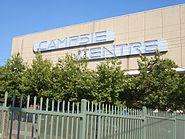| Main | Births etc |
|---|
| Campsie Sydney, | |||||||||||||
 Anglo Road Mall, Campsie | |||||||||||||
| Population: | 21,218 [1] | ||||||||||||
| Postcode: | 2194 | ||||||||||||
| Location: | 13 km (8 mi) south-west of Sydney CBD | ||||||||||||
| LGA: | City of Canterbury | ||||||||||||
| State District: | Canterbury | ||||||||||||
| Federal Division: | Watson | ||||||||||||
| |||||||||||||
Campsie is a suburb in Inner West of Sydney, New South Wales, Australia. Campsie is located 13 kilometres south-west of the Sydney central business district, on the southern bank of the Cooks River. Campsie is the commercial and administrative centre of the City of Canterbury.
History
Campsie was named after the Campsie parish in Stirlingshire, Scotland.
Aboriginal culture
Indigenous Australians lived in this area for thousands of years! In 1770, the land along the Cooks River was explored by officers from HM Bark Endeavour.
European settlement
In the early days of European settlement, the land in this area was mostly used for farming. The southern parts of Campsie were part of the Laycock estate, that extended to most of Kingsgrove. The area between South Campsie and the Cooks River was known as the Redman estates. John Redman was granted 100 acres (0.40 km2) in the 1812 and he later purchased the area to the east, which was a land grant of 200 acres (0.81 km2) to Thomas Capon in 1817.
The railway was completed in 1895, encouraging suburban development and leading to the area becoming heavily populated. The line passed through the Campsie Park estate which was owned by the Anglo-Australian Investment Company. A large wooded area was cleared for the construction of the station on Beamish Street. The first post office opened in April 1900 and the public school opened in 1908.[2]
The earliest model suburb in New South Wales was Harcourt, between Canterbury and Burwood, developed by William Phillips from 1889. The 200 acres (0.81 km2) was covered in scrub and inhabited by wild birds. The land was cleared and the streets were called avenues on the model of New York City. Although the suburb no longer exists, the Harcourt name remains as a locality and a public school on First Avenue.[3]
The Town Hall of the Municipality of Canterbury was moved to Campsie in 1962. The City of Canterbury was declared in 1993.
Demographics
Campsie is widely known to be home to a large east Asian, primarily Chinese and Korean, community. There is also a substantial number of ethnic Europeans.
In the 2011 Census, 21,218 people lived in the suburb of Campsie. 28 per cent of them were born in Australia, 21.8% were born in China, 5.1% were born in Korea, and 4% were born in each of India, Vietnam and Lebanon. The most common responses for religion in the suburb of Campsie were No Religion 23.0%, Catholic 21.5%, Buddhism 12.4%, Hinduism 6.7% and Eastern Orthodox 6.4%.[1]
Commercial area
Campsie has a mixture of suburban residential, retail and light industrial developments. The main shopping centre is situated along Beamish Street, close to Campsie railway station and surrounding streets. The Campsie Centre is a shopping centre located between Amy Street and Evaline Street. It contains supermarkets, a discount department store, many specialty shops, cafes, a motor registry, and a library. Commercial and light industrial developments run along the length of Canterbury Road.
Canterbury Hospital is a district hospital located on Canterbury Road.[4]
Transport

Intersection Beamish Street and Evaline Street
Campsie railway station is located on the Bankstown line of the CityRail network. The line was opened in 1895 and electrified in 1926. Two additional tracks were laid for goods traffic.
Beamish Street runs north-south for 1.6 kilometres and is characterised by retail and commercial developments over most of its length. Canterbury Road is a major arterial route, 11 kilometres long and connecting the inner suburbs of Sydney with Bankstown and suburbs further to the south-west.
Landmarks
- Campsie Public School, Harcourt Public School, St Mels Primary School.
- Canterbury Hospital
- Cooks River
Politics
Campsie is part of Central Ward of the City of Canterbury and together with Belmore and Lakemba elects three councillors to the city council.
For New South Wales state elections, the suburb is in the Electoral district of Canterbury. The district includes surrounding suburbs of Canterbury, Earlwood, Hurlstone Park, Croydon Park, western Dulwich Hill, eastern Belfield and northern Turrella.
For federal elections, Campsie is in the electoral division of Watson. In state and federal elections, Campsie residents predominantly vote for the Australian Labor Party.
References
- ^ a b Australian Bureau of Statistics (31 October 2012). "Campsie (State Suburb)". 2011 Census QuickStats. http://www.censusdata.abs.gov.au/census_services/getproduct/census/2011/quickstat/SSC10446?opendocument&navpos=220. Retrieved 29 April 2013.
- ^ Book of Sydney Suburbs, Frances Pollon (Angus and Robertson) 1990, p.48
- ^ Book of Sydney Suburbs, p.48
- ^ Canterbury Hospital
- Canterbury City Council website, "Local History and Heritage"
External links
| ||||||||
| This page uses content from the English language Wikipedia. The original content was at Campsie, New South Wales. The list of authors can be seen in the page history. As with this Familypedia wiki, the content of Wikipedia is available under the Creative Commons License. |








